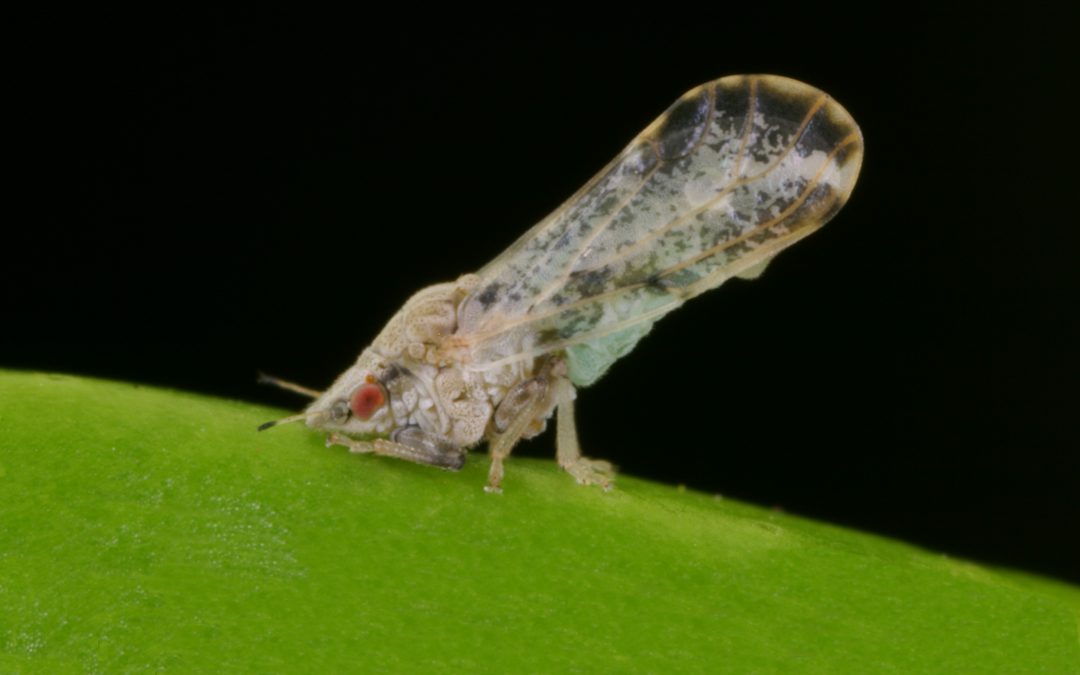
by Mark Tancig | Jan 13, 2022
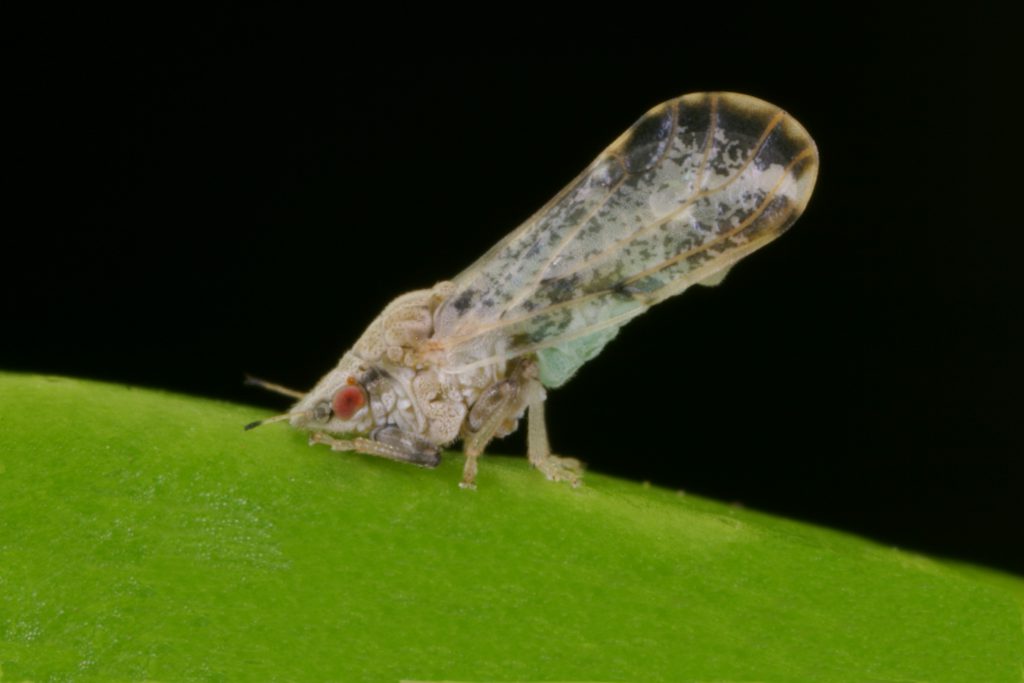
Asian citrus psyllid, Diaphorina citri. UF/IFAS/Entomology Photo: Michael Rogers.
In late 2016, as many of us were enjoying the harvests from our backyard citrus, a bacterial plant disease that can affect all citrus, citrus greening, was widespread in central and south Florida but had not made it this far north. That year, the vector, the insect that spreads the disease from tree to tree, had been found in Leon County and a few other surrounding Panhandle counties, but the disease had not. By mid-2017, the disease had been confirmed in Franklin County and we hoped that our cooler temperatures could keep the insect and disease at bay. Well, I regret to inform you that the disease has also now been confirmed in Leon County, growing in a residential yard in Tallahassee. Now that it is confirmed in non-coastal (and cooler) north Florida locations, I thought a review of the signs and symptoms – as well as what to do with your tree if you suspect or confirm greening – would be helpful.
The tricky part about diagnosing citrus greening is that it has symptoms that look very similar to soil nutrient deficiency symptoms, especially when first infected. This is a good time to mention that citrus require certain micro-nutrients for optimal growth and a citrus-specific fertilizer product should be used when applying fertilizer. Both the disease and certain nutrient deficiencies cause yellowing of the leaves. With greening, the yellowing is typically blotchy and/or not in any particular pattern. Nutrient deficiencies typically cause unique patterns of yellowing, such as a V-shape or artistic-like symmetrical patterns on each side of the leaf’s midvein. The soil’s acidity, or pH, can also cause some nutrients to not be taken up by the plant even if they are present. Soil testing, available from your local UF/IFAS Extension office, and scheduled fertilizations with a citrus-specific fertilizer can ensure that nutrients are not to blame for the discoloring of leaves. More advanced stages of the disease cause such symptoms as leaf drop, fruit drop, lop-sided fruit, uneven inner fruit cores, and reduced fruit quality.
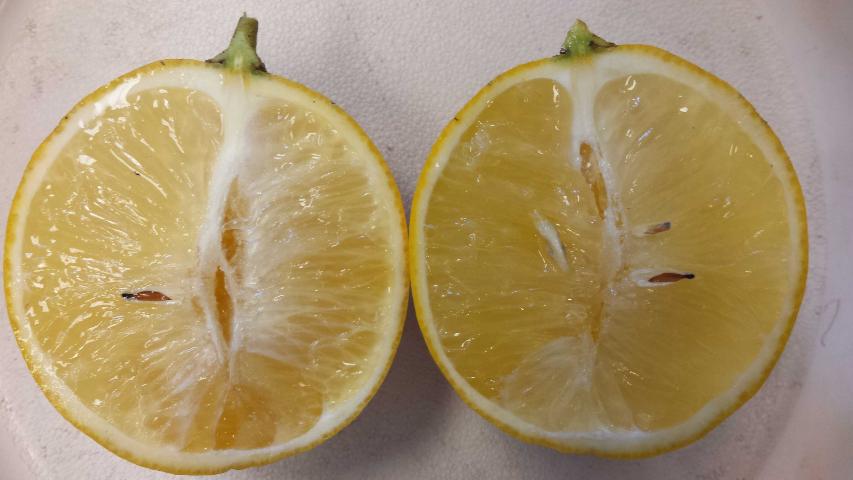
Citrus greening symptoms of the fruit. Photo by Brooke Moffis.
A more obvious sign of potential problems for your citrus are the presence of the insect vector, the Asian citrus psyllid. This is a tiny little insect that goes from one leaf to the other sucking up plant saps for food and unknowingly spreading the bacterium responsible for citrus greening. You can monitor for them by looking closely at the new flushes of growth. If the psyllids are present, you will likely notice most their small, peach-colored eggs and/or white, waxy secretions. If found, it doesn’t necessarily mean that your tree has greening, but you will want to minimize the chance that they could carry it to your tree. The psyllids can be treated with pesticides, ranging from the less harsh options (horticulture oils, neem oil, kaolin clay) to the more hardcore stuff (malathion, carbaryl, imidacloprid). Of course, always read the label of any pesticide before use and/or consult a qualified landscape professional for assistance.
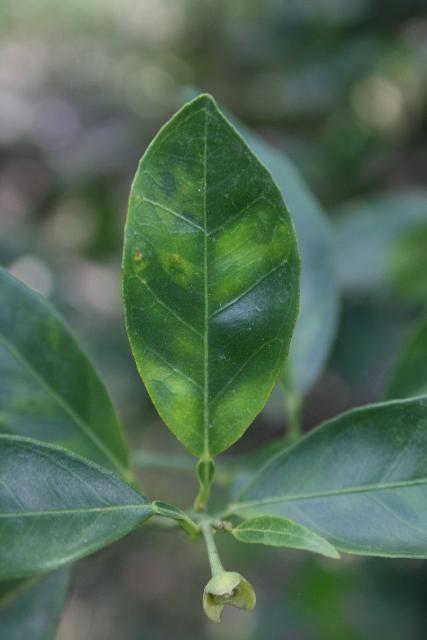
Blotchy leaf symptom of citrus greening. Photo by Jamie D. Burrow.
If you suspect your tree is infected, a diagnostic test can be performed by UF/IFAS plant pathologists at the North Florida Research and Education Center (NFREC) in Quincy to confirm. The test does cost $50, which may seem a little steep, but it’s an expensive lab analysis to run and may be worth piece of mind.
If citrus greening is confirmed in your tree, the right thing to do, unfortunately, is to remove and burn the plant material as there is no known cure. While the Florida Department of Agriculture and Consumer Services (FDACS) doesn’t have any removal requirements for infected dooryard citrus, tree removal is best to prevent additional spread of the disease to other trees, especially those grown by commercial producers in our area. This may seem drastic but eventually the health of the tree and quality of the fruit will decline to a point where you will want to remove it anyway. Don’t forget that movement of any citrus plant outside of the state is prohibited for the very reason of preventing spread of citrus diseases.
You may be asking, “Is it okay to replace it with another citrus tree?” The answer is yes you can, but you do risk re-infection and will want to be monitoring the new planting.
You may also be thinking, “What is going to happen to Florida citrus?” That’s a question that many researchers at UF/IFAS are trying to answer. There is some hope that intense irrigation and nutrient management, as well as specific pruning practices, can help infected trees continue to be profitable for commercial growers. Recently, UF/IFAS researchers were awarded several grants to try and figure a way out of this problem. Some of the lines of research focus on exploring the resistance found in different citrus varieties, including an Australian lime that appears to be greening resistant. This could potentially be used as a future rootstock. Another approach is to try and treat the plants with a particular peptide that would prevent the disease from binding in the insect’s gut. Isn’t that amazing?
Until a fix is found, we should be monitoring for this disease in our area and taking steps to reduce its presence through controlling the psyllids and removing infected trees. If you suspect a tree has greening, please contact your local county Extension office to review the symptoms and discuss your options.
Much more information on citrus greening is available at the following Ask IFAS website: https://edis.ifas.ufl.edu/entity/topic/citrus_greening and from this 2017 article – https://nwdistrict.ifas.ufl.edu/phag/2017/03/03/disease-alert-citrus-greening-and-asian-citrus-psyllids-found-in-the-panhandle/.
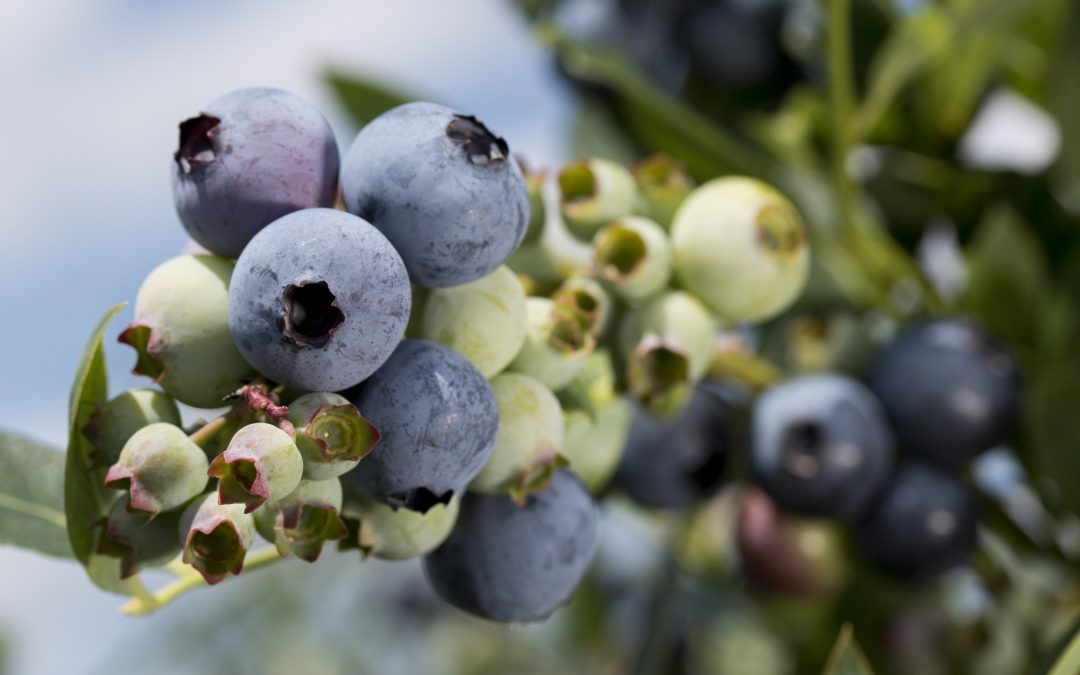
by Ray Bodrey | Jun 24, 2021
We have many choices of fruit that can be grown in the Florida Panhandle. For us hobby or dooryard growers, fruit trees can be an interesting crop to manage and most find it to be a beautiful addition to home landscapes. However, temperature and variety selection are key.
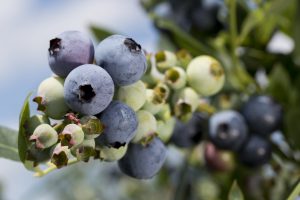
Blueberry Crop at UF/IFAS Plant Science Research & Education Unit. Photo Credit: Tyler Jones, UF/IFAS
Most fruit trees grown in the Panhandle are more temperate varieties, rather than tropical and subtropical fruits. Depending on the variety, winters in northern Florida may be too cold or may be too long for some fruit trees. Cold hardiness is a term used on fruit tree labels and reference guides. This refers to the plant’s ability to survive cooler or even freezing temperatures. In contrast, summer heat can also play a role in survivability. Some varieties are intolerant to excessive heat and humidity. The U.S. Department of Agriculture has developed a Plant Hardiness Zone Map that is helpful in selecting a variety of fruit tree: http://planthardiness.ars.usda.gov/PHZMWeb/. This is a standard by which gardeners and growers can determine which plants will thrive in their location. Northern Gulf County is in Zone 8b (15 to 20 degrees F), while coastal Gulf is in Zone 9a (20 to 25 degrees F).
Chilling requirement is another important topic when deciding on variety. Temperate zone fruit go through a “rest period” during the dormant months. For these fruit trees, a minimum length of time of cooler weather is needed for proper flowering to occur once favorable temperatures arrive. This rest period is essentially a reset. For the Panhandle, temperatures below 45 degrees F are known as chilling temperatures. The number of hours during the fall and winter that reach below this temperature equals the total chilling hours. For the Panhandle, this is rarely fewer than 500 hours. A plant that does not receive ample chilling will most likely be slow in bud and leaf development. Leaf expansion will be in increments throughout the year instead of in one period. On the other hand, colder, longer winters can cause fruit trees to end the rest stage early and begin to bud as soon as warmer temperatures arrive. This circumstance can cause cold injury later, as the Panhandle is historically known for late cold spells.
Citrus is a dooryard fruit, however it’s a subtropical fruit tree and not technically temperate. However, there are some varieties that thrive in the Panhandle. Another key to growing citrus, is to select varieties with different fruit maturity seasons. This way you can enjoy citrus year-round.
Some examples of dooryard fruit trees and varieties that are suitable for northern Florida are:
Apple: ‘TropicSweet’, ‘Anna’, ‘Dorsett Golden’
Blueberry: ‘Rabbiteye’, ‘Climax’, ‘Highbush’
Grapefruit: ‘Marsh’, ‘Ruby Red’
Lemon: ‘Myer’
Nectarine: ‘Suncoast’
Orange/Mandarin: ‘Navel’, ‘Parson Brown’, ‘Valencia’, Satsuma
Peach: ‘Gulfcrest’, ‘Gulfking’, ‘Gulfprince’
Pear: ‘Ayers’, ‘Baldwin’, ‘Kieffer’
Pecan: ‘Elliot’, ‘Stuart’, ‘Moreland’
So, where do I find information on varieties? The UF web publication “Dooryard Fruit Varieties” is a great resource. Also contact your local county extension office for more information.
Information for this article can be found in the UF/IFAS EDIS publication: “Dooryard Fruit Varieties” by J. G. Williamson, J. H. Crane, R. E. Rouse, and M. A. Olmstead: http://edis.ifas.ufl.edu/pdffiles/MG/MG24800.pdf
UF/IFAS Extension is an Equal Opportunity Institution.
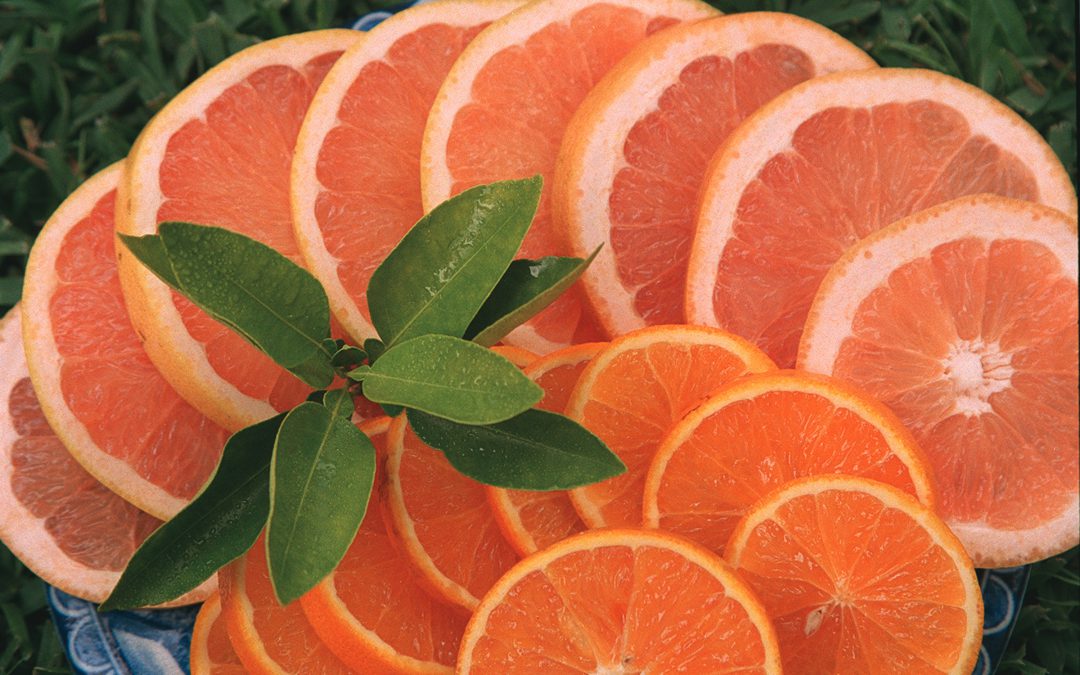
by Ray Bodrey | Apr 8, 2021
The Sunshine State produces a wide selection of citrus, with a number of varieties that can be grown right here, in your Panhandle dooryard. And, what is more satisfying than picking fresh fruit from your very own trees? So, are you looking for a different variety to plant? The ‘Parson Brown’ sweet orange may be of interest. It can certainly add uniqueness to your dooryard citrus grove.
Originating in China, orange varieties began being introduced in Europe in the fifteenth century. As for introduction to America, Columbus brought orange seeds to the new world on his second voyage in 1493. The first plantings in Florida were around 1513 in the settlement of St. Augustine. For the ‘Parson Brown’, a chance seedling originated at the home of Reverend N.L. Brown near Webster in 1856. Sumter and Seminole counties are still home to some of the largest densities of ‘Parson Brown’ orange trees in the state.
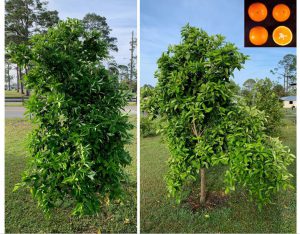
Figure 1: ‘Parson Brown’ Sweet Orange. Credit: D.P.H. Tucker, Ray Bodrey, UF/IFAS.
The Parson Brown, however, is often overlooked. The most popular dooryard sweet orange varieties grown throughout Florida are Navel, Hamlin, Valencia and Pineapple. Availability of this variety in our region is not easily found either, as you may have to search to find a tree.
Unlike the short, round appearance of many citrus trees, the Parson Brown tends to grow tall and slim. The Parson Brown’s more upright tree structure is very distinctive. A specimen will certainly stand out in a grove. The fruit and yield rival a Hamlin orange, particularly when grown in heavy, hammock soils rather than sandy soils with low organic content. The variety is also not as marketable as the Hamlin on a commercial level, due to the heavier seediness. You can expect at least 10 seeds per fruit. Average diameter of fruit is between 2 ½” to 2 ¾”. Harvest season for fruit is generally between October and January. Evidence suggests that along with the ‘Sugar Belle’ variety, the ‘Parson Brown’ may be more disease resistant, specifically more tolerant to citrus greening. HLB or citrus greening is a disease that has devastated both commercial production and dooryard citrus across the state.
Contact your local county extension office for more information. Also, for more information on growing citrus in Florida, see the UF/IFAS Extension EDIS publication, “Citrus Culture in the Home Landscape” by Robert E. Rouse and Mongi Zekri.
UF/IFAS Extension is an Equal Opportunity Institution.
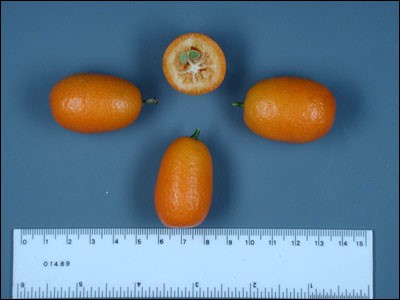
by Mary Salinas | May 5, 2016
The panhandle of Florida is a great place to grow citrus with our plentiful sunshine and sandy soil. But some varieties do better than others. Here are some that thrive in the more northerly climes of Florida:
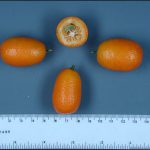
Nagami kumquat. Photo credit: UF/IFAS.
- Satsuma mandarin is cold hardy to 15°F once established. There are a few different available cultivars with fruit ripening October through December. Fruit needs to be picked promptly when ripe.
- Kumquat is cold hardy to 10°F once established. ‘Nagami’ and ‘Meiwa’ are the two common cultivars of the small tart fruits. Fruit matures in fall and winter and holds fairly well on the trees.
- Calamondin is a lesser known variety that bears small fruit that resemble tangerines. The tart fruit is great for jams and chutneys. Fruit is borne all year.
- Some of the sweet oranges that do well in the panhandle are Navel, Hamlin and Parson Brown. They are cold hardy to 14°F once established and are harvested November through January.
- Minneola or Honeybell tangelo is also hardy to 14°F and harvested in January. This is a cross between a Duncan grapefruit and a Darcy tangerine. This bell-shaped fruit is very juicy and sweet. Unlike the other citrus varieties, it needs another citrus nearby for cross-pollination in order to produce an abundant crop.
- Meyer Lemon is the choice to make if you would like to grow lemons in the panhandle. Other lemons may be damaged by our occasional freezes.
Grapefruit and lime can be grown – although unreliably – on the coast with protection from northwestern winter winds. They are much more susceptible to freezes in more northerly panhandle locations.
In order to have the healthiest and most productive trees, learn about how to properly care for citrus and how to recognize and combat the pests and diseases that occur.
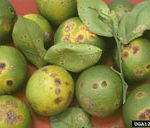
Citrus canker symptoms on leaves, fruit and stem. Photo by Timothy Schubert, FDACS
There are threats to our dooryard and commercial citrus from pests and disease. Only vigilance will help to combat the challenges so that we may continue to grow and enjoy our citrus. What can we do to protect our citrus?
- Report any serious diseases like suspected citrus canker or citrus greening to the Division of Plant Industry by calling toll-free 1-888-397-1517. Inspections and diagnosis are free. Citrus canker has been confirmed in south Santa Rosa County in the past 3 years.
- Purchase citrus trees only from registered nurseries – they may cost a little more but they have gone through an extensive process to remain disease and pest free. That will save you $$ in the long run!
- Don’t bring plants or fruit back into Florida – they may be harboring a pest!
- Citrus trees or fruit cannot move in or out of the State of Florida without a permit. This applies to homeowners as well as to the industry. This rule protects our vital dooryard trees and citrus industry.
For more information please see:
Save Our Citrus Website
UF IFAS Gardening Solutions: Citrus
Citrus Culture in the Home Landscape
UF IFAS Extension Online Guide to Citrus Diseases
Your Florida Dooryard Citrus Guide – Common Pests, Disease and Disorders of Dooryard Citrus











